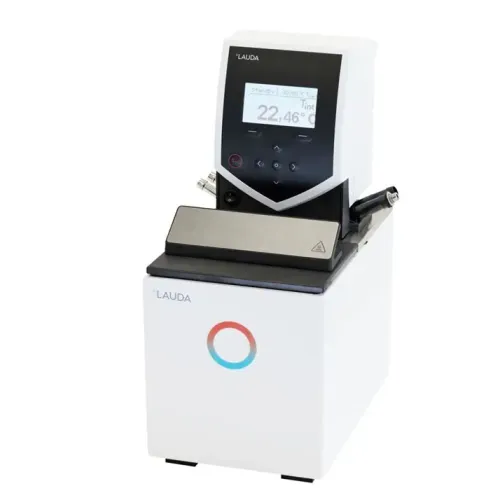The LAUDA ECO E 4 S is a high-precision heating thermostat designed for demanding laboratory applications. Featuring a stainless steel bath, electronic PID controller and graphic LCD display, it guarantees stable temperature control between 20 °C and 200 °C. Its six-stage adjustable Vario pump enables optimised internal and external circulation. Thanks to its modular interfaces and class III safety rating, it is suitable for flammable and non-flammable liquids. Compact, powerful and scalable, the ECO E 4 S is the ideal tool for professionals seeking performance and safety.
ECO E 4 S Heating Thermostat


Description
LAUDA ECO E 4 S Heating Thermostat – Precision and Reliability for Laboratory Applications
The LAUDA ECO E 4 S is a high-performance laboratory heating thermostat designed to provide precise and reliable temperature control in scientific and industrial environments. This model embodies LAUDA's technological excellence, combining innovation, safety and ergonomics in a compact format.
Featuring a stainless steel bath with a capacity of 3 to 3.5 litres, the ECO E 4 S is equipped with an electronic PID control system that ensures exceptional temperature stability of ±0.01 K. It operates in a temperature range from 20 °C to 200 °C, making it suitable for a wide variety of applications, including those requiring flammable liquids thanks to its safety class III.
The user interface is intuitive, with a monochrome graphic LCD display showing the actual and target temperatures simultaneously. Menu navigation is in plain language via cursor keys and function keys, making configuration and daily use easy. A special Tmax key allows overheating protection to be managed.
The integrated Vario pump offers six adjustable performance levels, allowing precise control of the flow rate between internal and external circulation, without direct contact with the bath. The maximum flow rate is 22 L/min, with a pressure of 0.6 bar, ensuring even heat distribution.
The thermostat is also upgradeable, with the option of adding interface modules such as RS 232/485, Profibus, Ethernet-USB, or Pt 100/LiBus modules for external control and remote control via console. A USB port is included as standard for connectivity and data management.
The LAUDA ECO E 4 S has a built-in programmer that can manage a programme with up to 20 segments, ideal for complex thermal cycles.
With compact dimensions of 168 x 272 x 376 mm and a weight of only 7 kg, this thermostat fits easily into any workspace. It is powered by 230 V, 50/60 Hz, with a maximum consumption of 2.1 kW.
The LAUDA ECO E 4 S is an essential choice for laboratories and demanding industrial environments. It combines thermal precision, safety, flexibility of use and modern connectivity, while remaining simple to use and maintain.
Features
- Electronic PID controller for precise regulation
- Monochrome graphic LCD display
- Intuitive navigation in plain language
- 6-stage adjustable Vario pump
- Contactless control of internal/external circulation
- Standard USB interface
- Integrated programmer (1 programme, 20 segments)
- Optional interface modules: RS 232/485, Profibus, Ethernet-USB
- Pt 100/LiBus module for external control
- Stainless steel bath with drain valve
- Integrated cooling coil
- Safety class III for flammable and non-flammable liquids
Technical Details
- Working temperature range: 20 °C to 200 °C
- Ambient temperature range: 5 °C to 40 °C
- Temperature stability: ±0.01 K
- Max. heating power: 2 kW
- Max. power consumption: 2.1 kW
- Max. current: 10 A
- Max. pump flow rate: 22 L/min
- Max. pump pressure: 0.6 bar
- Bath volume: 3.0 to 3.5 L
- Bath dimensions: 135 x 105 x 150 mm
- Overall dimensions: 168 x 272 x 376 mm
- Weight: 7 kg
- Power supply: 230 V; 50/60 Hz
- Plug type: SEV 1011, SEV 5934/2, T23
Compatible Accessories
- Bath cover
- Closing cap